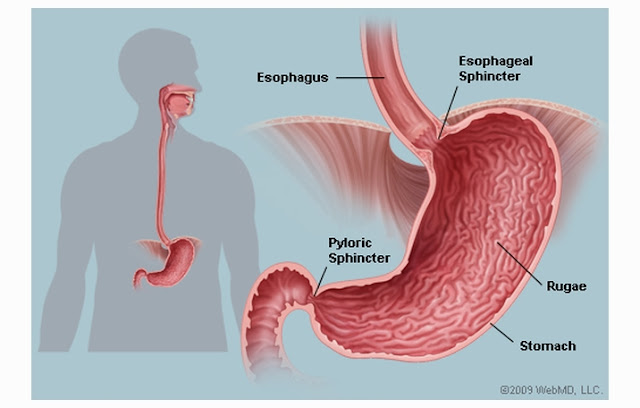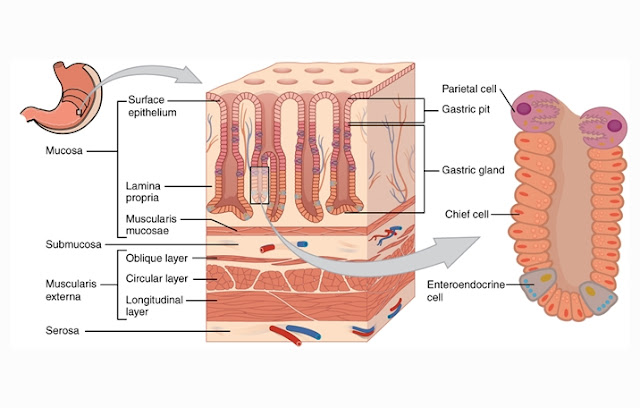A. UNDERSTANDING THE DEFINITION OF
STOMACH (GASTRIC)
Stomach is a digestive organ that is shaped like a
pouch and is located in the left abdominal cavity above the diaphragm. Another
name is the gastric. Gastric main function is to store and process food.
Gastric pH less than 2 degrees, which are highly acidic. At both ends of the
stomach (before and after passage of the stomach) there are two narrowing tube
so that the food is being processed in the stomach do not go down or up to
another organ when the gestation takes place. On the inside of the gastric
there are glands that produce gastric juice. The size of the stomach at each
individual is different, but usually able to accommodate 1.5 liters of food.
B. THE FUNCTIONS OF STOMACH (GASTRIC)
- To store and process food.
- To destroy harmful bacteria and micro-organisms contained in food. pH of stomach is highly acidic so they are capable to killing bacteria.
- Begins the digestion of fat.
- Transform proteins into peptone.
- Changing caseinogen into casein.
- It can also control the production of hormones.
The Stomach has a wall structure that similar to most
of the small intestine and other digestive organs. Hull structure composed by
four walls below (From outside to inside):
1. Layer
Serous
Is the outer layer that serves as a protection of the
stomach. Cells contained in this layer can produce liquid that reduces friction
between the stomach with other digestive organs.
2. Muscle
Layer
Muscle layer of the stomach is a layer of smooth
muscle that works involuntary. There are three types of muscle fibers, elongated,
circular and diagonal. The combination of these three types of muscle
contraction will produce gastric peristalsis which serves to break down the
food and took it to the next digestive organ.
3. Submucosa
Layer
Layer that composed by connective tissue containing
blood vessels, lymphatics, nerves and mucous glands. The blood vessels in the
submucosal layer of the stomach plays an important role in passing the food and
nutrition.
4. Mucous
Layer
This layer served in the secretion process. Mucous
layer serves to issue various types of fluids such as enzymes, stomach acid,
and hormones. There are 3 types of cells in the mucosa layer, namely:
- Goblet cells, function to produce mucus or slime that keeps the inner layer not damaged.
- Parietal cells, used to produce stomach acid and serves to activate the pepisn enzyme.
- Chief cell serves to produce pepsinogen (pepsin enzyme in an inactive form). This enzyme is produced in an inactive form so they do not digest their own protein.
D. PARTS OF STOMACH (GASTRIC)
1. Cardiac
The first part of the hull which serves as the
entrance of food from the esophagus (gullet).
2. Fundus
The central part of the stomach that have rounded
shape. This section is often called the corpus (body of the stomach).
3. Pylori
The lower part of the stomach is associated with the
small intestine.
In the stomach there are two valve (sphincter), is a
narrowing at both ends. At the end of the hull bordering with esophagus,there
is cardia sphincter, whereas at the end of the hull bordering with small
intestine, there is pylori sphincter. Both sphincter function to keep food
stays in the stomach during the digestion process takes place, but it also
prevents stomach acid to get into other organs.
E. GASTRIC JUICE COMPOSITION AND FUNCTION
- HCL (Stomach Acid), a is highly acid liquid produced by parietal cells. Function to kill bacteria in food, stimulate the intestines liver and pancreas, change pepsinogen into pepsin.
- Pepsin, serves to convert protein into albumosa + peptone.
- Lipase, serves to transform fat into fatty acids + glycerol.
- Renin, serves to convert protein from milk to lactose.
- Gastrin, serves as a hormone that increases production of gastric glands to their secretion.
- Mucin, serves to protect the stomach wall.
F. DIGESTION PROCESS IN THE STOMACH
(GASTRIC)
1. Mechanical
Process
Esophagus move food to enter the stomach, the food is
then digest in the stomach for approximately 2-5 hours. Stomach has a layer of
muscle that will combine to perform mechanical digestion to break down food.
The combination of the contraction of their muscles is going to create a
movement that will encourage the food slowly. The movement is called
peristalsis. Peristaltic movements will occur every 15-25 seconds.
2. Chemical
Process
Chemical digestion process that occurs in the stomach
conducted by the gastric juice. In this case the food is broken down into
simpler form to be easily absorbed in the intestine. Gastric juice will keep
food free from bacteria and acidic. Furthermore, the food will move towards the
small intestine and the condition of the pH is neutralized by other organs such
as the pancreas and intestine.
G. EMPTYING PROCESS
Gastric emptying occurs because nerve stimulation as
a result of the presence of food in the stomach. And the presence of the
gastrin hormone which is a component of gastric juice will stimulate the
cardiac sphincter to contract, increasing gastric movement, and relaxation of
the pyloric sphincter so that a process of making food go to the next digestive
organ. Gastric emptying all its contents into the small intestine approximately
2-6 hours after the food starts to digest. Gastric emptying speed is highly
dependent on the concentration of the food there.
Some of the factors that affect the rate of gastric
emptying are :
- The Pump quality of the pyloric sphincter and the peristalsis
- volume of food
- Gastrin hormone
- The Hormonal System
- Concentration of Food




